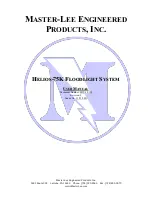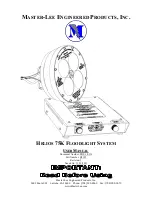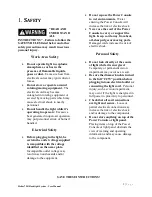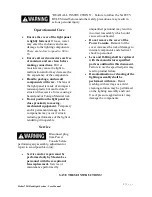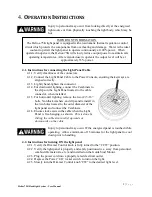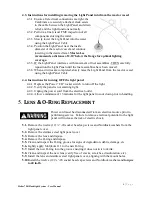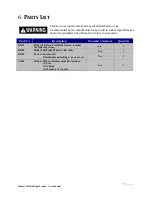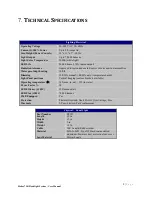
4 |
P a g e
Helios 75K Floodlight System – User Manual
2.
E
LECTRICAL
R
EQUIREMENTS
•
Connect the Power Console plug (included) to a 120-Volt branch circuit with a minimum
breaker rating of 15-Amps.
•
The Helios-75K is provided with a cord having a 3-prong, grounded plug, w/ locking
system. Only plug the cord into outlets also having a 3-prong outlet of the same size.
•
Replace damaged cords immediately. Use of damaged cords can shock, burn or
electrocute.
•
If an extension cord is necessary, a cord with adequate size conductors should be used to
prevent excessive voltage drop, loss of power or overheating. The table below shows the
correct size to use depending on cord length.
Recommended Size of Extension Cord
Cord
Length
(ft)
Cord Size in A.W.G
25
18
50
16
100
12
3.
I
NSPECTION
•
Inspect light panel and lens for water infiltration and/or damage.
Failure to replace
the lens, if visibly damaged or discolored, may result in breakage, poor performance, or
water leaks. The lens should be completely transparent. Discoloration of the lens may
indicate embrittlement due to excessive radiation exposure.
•
Inspect all bracket and lens cover fasteners for signs of degradation, damage, or
wear.
Failure to replace damaged fasteners may result in electrical and/or mechanical
failure.
•
IF used in the reactor core or within close proximity of irradiated fuel assemblies,
THEN perform a visual inspection after approximately 7-10 days of exposure to the
radiation.
Failure to inspect and replace the lens, as necessary, may increase the risk of
breakage and reduce the emission of light.
•
Inspect cable strain relief and carabiners for signs of degradation, damage, or wear.
Failure to replace damaged support components may result in damage or personnel
injury.
•
Inspect electrical cables for cuts, wear, fretting, kinks, or any visible signs of
degradation.
Use of damaged electrical cables may increase the risk of electrical shock.
•
Inspect electrical fittings for wear, damaged threads, or bent pins.
Use of damaged
electrical fittings may increase the risk of electrical shock.
•
Inspect components for cleanliness.
Dirt, oil, or chemicals may impair performance
and longevity of the components.

